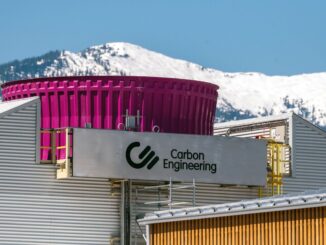
The aviation industry is serious about reducing its carbon footprint — a sector that contributes roughly 2% of all greenhouse gas emissions. To that end, a new plant is breaking ground today in Washington State to transform CO2 into jet fuel — a technology that could clean up air travel.
The U.S. Air Force has tested the product, affirming that existing planes can add it without engine changes. The carbon can comprise as much as 50% of the jet fuel, resulting in 90% fewer lifecycle emissions.
“We will sell the output, and commercial flights will use it. But it will also serve to de-risk the investment,” says Twelve’s vice president of project development Andrew Stevenson, in a talk with this writer. “It will be more expensive to start, although we have a pathway if renewable energy continues to get cheaper. We will then produce a cost-competitive fuel.”
The aviation sector consumes 100 billion gallons of fossil fuels and emits 1 billion tons of CO2 annually. Electrifying planes is one option, but those flights are limited to a few hours. And sustainable aviation fuels are another choice. Enter E-Jet fuel that is carbon-neutral and fossil-free — derived from CO2.
Biogenic sources such as ethanol plants, pulp and paper mills, and waste processing are the sources of CO2 feedstock. And while other companies make jet fuel by recycling or altering CO2, Twelve’s process uses an electrolyzer, similar to those that separate hydrogen from water. Twelve’s technology uses water and renewable electricity to transform CO2 into jet fuel.
The plant will go live in mid-2024, producing initially 40,000 gallons annually. Shopify, MicrosoftMSFT, and Alaska AirlinesALK will be its first customers. While Microsoft has an investment interest, the other companies are primarily concerned with hitting their net-zero goals — using the modified CO2 to claim an emission reduction tied to their supply chains. The technology is, therefore, crucial to their long-term sustainability goals.
“The life cycle emissions reduction of our fuel are substantial compared to conventional jet fuel,” says Stevenson. “It uses a lot of electricity. As long as we use renewable energy, there is no net emissions. It is why having low-cost renewable electricity is so important.”
To be sure, traditional fossil fuels have a current cost advantage. But building the infrastructure to extract fossil fuels started long ago — an endeavor that was also expensive. Over the decades, the costs fell because the processes became more efficient while companies built economies of scale. And now the investments have depreciated. Nevertheless, oil and gas developers have not paid the total price of externalities — or the environmental and health-related costs.
According to the International Energy Agency, aviation now accounts for 15% of global oil demand. About half of its contents must come from biofuels such as corn or wood chips to be considered renewable.
LanzaTech has an advanced carbon recycling technology that converts waste carbon gases into ethanol and chemicals — in collaboration with the national labs and specifically with the Pacific Northwest National Laboratory (PNNL). PNNL developed the processes to convert the ethanol into a clean jet fuel that emits fewer CO2 emissions across the fuel’s lifecycle, says the Department of Energy. Virgin Atlantic has used the fuel on its flights.
Indeed, multiple global companies are applying for patents to convert CO2 into jet fuel. For instance, Air Company is using CO2 and renewable energy to supplement jet fuel, attracting Jet Blue and Virgin Atlantic. Dimensional Energy does something similar, capturing CO2 from cement production.
“Our goal is to de-risk the technology and the process — to operate successfully at a larger scale,” says Twelve’s Stevenson. “We want to scale up and build other facilities worldwide.”
If it works as advertised, the aviation sector can go a long way toward cutting its carbon footprint — a good move for the industry and its customers.



